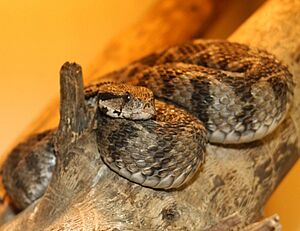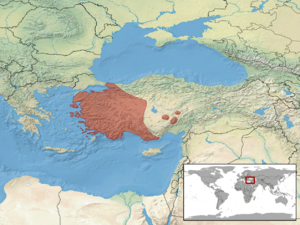Montivipera xanthina facts for kids
Quick facts for kids Montivipera xanthina |
|
|---|---|
 |
|
| Conservation status | |
| Scientific classification | |
| Genus: |
Montivipera
|
| Species: |
xanthina
|
 |
|
| Synonyms*Montivipera xanthina — Nilson et al., 1999 |
|
|
|
The rock viper (scientific name: Montivipera xanthina) is a type of venomous snake found in parts of Greece and Turkey. It also lives on some islands in the Aegean Sea. This snake is also known by other names like the coastal viper or Ottoman viper. Like all vipers, it can inject venom.
Contents
What Does the Rock Viper Look Like?
Rock vipers usually have a grey or white body. They have a black zig-zag stripe running down their back. Some rock vipers are completely black. Their scales on their back are keeled, meaning they have a ridge down the middle.
These snakes typically grow to be about 70 to 95 centimeters (27.6 to 37.4 inches) long. However, on some Greek islands in the Aegean Sea, they can grow even larger. The biggest ones found there can reach up to 130 centimeters (51.2 inches) in total length.
Where Do Rock Vipers Live?
The rock viper likes to live in wet places. It prefers areas with lots of rocks and thick plants. These places give them good spots to hide and hunt.
What Do Rock Vipers Eat?
Rock vipers mainly eat rodents and other small mammals. They also hunt native birds. Sometimes, they might also eat lizards.
Other Names for the Rock Viper
This snake has several common names. People call it the:
- Rock viper
- Coastal viper
- Ottoman viper
- Turkish viper
- Near East viper
- Mountain viper
Where Can You Find the Rock Viper?
You can find the rock viper in the very northeastern part of Greece. It also lives on many Greek islands in the Aegean Sea, such as Simi, Skiathos, Kos, Kalimnos, Samothraki, Leros, Lipsos, Patmos, Samos, Chios, and Lesbos.
In Turkey, it lives in the European part (called Eastern Thrace). It also lives in the western half of Anatolia, stretching inland towards Kayseri. You can also find it on islands near the Turkish mainland, like Chalki.
Is the Rock Viper Endangered?
The rock viper is listed as a species of "least concern" by the IUCN Red List. This means it is not currently considered to be in danger of disappearing. It has a wide distribution, and there are many of them. Its population is not decreasing quickly.
However, it is still a protected species. It is listed under Appendix II of the Berne Convention. This means it is strictly protected.
Understanding Rock Viper Venom
There isn't a lot of detailed information about the rock viper's venom. However, like other vipers, its venom mainly affects cells and blood. It can cause damage to tissues and stop blood from clotting properly.
Even though the snake injects only a small amount of venom when it bites, the venom is very strong. Bites from this snake have been known to cause serious harm to adult humans. Young children or older people, especially if they get a lot of venom injected, can be at higher risk.
Studies have shown how strong the venom is. For example, one study in 1984 found that the average amount of venom a rock viper produces is about 10 milligrams (dry weight). The most venom found from one snake in that study was 18 milligrams.


